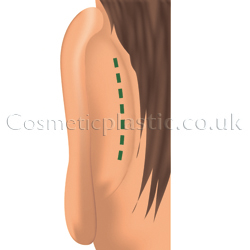Ear Correction / EarFold Creation
Approximately 1-2% of the UK population have prominent ears. A family trend can be seen on occasions. This is a common operation that can be performed at any age from childhood. People with prominent ears are sometimes teased, during their school years, at work or even in relationships. This can affect self-esteem and lower your confidence. The satisfaction rate is very high after this fairly common surgery.
What is Pinnaplasty (Otoplasty, Ear Pinning, EarFold Creation)?
Pinnaplasty (pinning back of sticking out ears) is an operation that reduces or reshapes the cartilage (gristle part under the skin) within the ear, to create the missing folds and allow the ear to lie closer to the side of the head. The operation can be performed at any age from 7 years old and above.
Earfold is a new concept introduced to create the earfold using a 24-carat gold plated device. This is usually done under a local anaesthetic (awake) through a small scar on the front of the ear.
Reduction of the size of the ear lobule is also one of the frequently requested operations. A small procedure can be performed to reduce the size.
The Surgery (Pinnaplasty, Otoplasty, Ear Pinning, Earfold Creation)
 The surgery is carried out from behind the ears, leaving a scar close to the groove between the ear and the side of the head that is easily concealed. The procedure can be carried out under local (while awake) or general anaesthesia (while you are asleep), depending on the age and preference of the patient. The surgery is usually done as a day case. Recently a new earfold device has been introduced.
The surgery is carried out from behind the ears, leaving a scar close to the groove between the ear and the side of the head that is easily concealed. The procedure can be carried out under local (while awake) or general anaesthesia (while you are asleep), depending on the age and preference of the patient. The surgery is usually done as a day case. Recently a new earfold device has been introduced.
Recovery (Pinnaplasty, Otoplasty, Ear Pinning)
There will be a stitch behind the ear that requires removing 7-10 days after surgery. The ears will be covered by a crepe bandage (almost like a turban) for the same period. The area should be kept dry until the stitches are removed. Caution is thereafter required when drying the face (particularly behind the ears) after washing. It might be best to use a hair dryer to dry behind the ears for the first couple of weeks. Once the crepe bandage has been removed, it is wise to wear a protective head-band (sweat band) or bandage when sleeping for 4 weeks, to avoid the ears being bent forward against the pillow. It is advisable to avoid sports and strenuous work/exercise for approximately 6 weeks.
Potential Risks (Pinnaplasty, Otoplasty, Ear Pinning)
Every surgical procedure carries a certain amount of risk, and it is important that you understand the risks involved in pinning back prominent ears.
The scar may become thick and red. Asymmetry is not uncommon. Sometimes the bandage can press on the front of the ear to produce a breakdown in the skin, which can take a long time to heal and in the extremely rare occasions may require a skin graft. Under or over correction of the ear are risks that may require further adjustment surgery. The ears are often a little numb after surgery.
Bleeding, infection, blood clots in leg veins and/or lung and further revisional surgery are general risks that can follow any operation.
The information provided gives you a basic understanding of the ear correction procedure but it may not answer all your questions, a lot depends on your individual circumstances. This website provides guidance and is not intended to be a substitute for a surgical consultation with Mr Fahmy in Shropshire, Chester, Cheshire or Wrexham, North Wales and Mid Wales.
For any enquiries, you can email Professor Fahmy on info@cosmeticplastic.co.uk . Your consultation will be directly with Professor Fahmy and the treatment will be performed by himself at the hospital of your choice either Pulford Medical Centre, Chester (Cheshire) or Spire Yale Hospital, Abergele & Wrexham (Wales). It is always advisable to bring a friend or a relative during your consultation, as it may further assist you in any questions you may have.
Notice of Copyright ©: 01 July 2008 - The documents and images on this website have been created by Prof. F Fahmy (author), who reserves all rights to their use for purpose of publication, sale, commercial gain, or promotion. Permission must be sought to download, reproduce, copy, print, or otherwise transform any of the documents or images on this website. The copyright for all pictures remains with Prof. F Fahmy.